Photos and text by Joseph Sapia
Garden and Afield in Helmetta-Monroe-Jamesburg, 2016, May 22, Sunday, to May 28, Saturday
From my yard in the Helmetta Road area of Monroe and the surrounding Pine Barrens
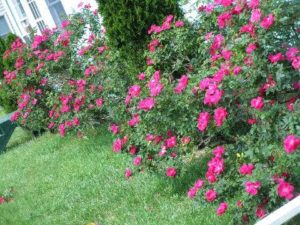
Knock-out roses
— “KNOCK OUT’ ROSES: The “Knock Out” roses are putting on a spectacular display, the best I recall since planting them in my yard in 2008.
— RACCOON/S AT THE BIRD-FEEDER: The battle continues between me and the raccoons at the bird-feeder. I have been putting the feeder in the garage at night, but the raccoon/s sometime beat me to the feeder.
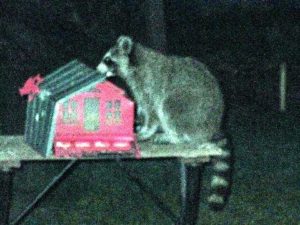
Raccoon at my backyard birdfeeder
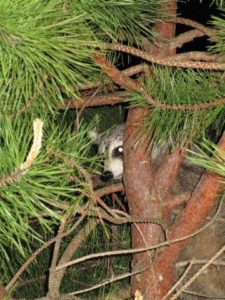
— CANADA GEESE GOSLINGS: Adult Canada geese are out and about with their goslings. The adults are amazing parents — and humans can learn from them, (Photo 6, at Helmetta Pond.)
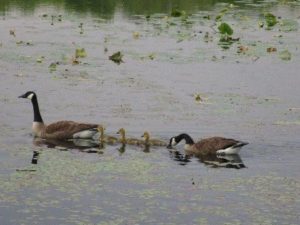
Canada Geese at Helmetta Pond
— NEW JERSEY STATE BIRD AT THE FEEDER: An Eastern goldfinch at one of my bird-feeders. Easily identified as a male because of the bright colors.
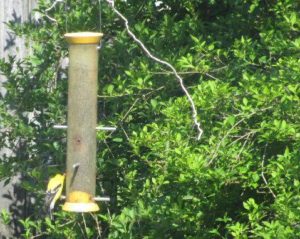
Eastern Goldfinch, the New Jersey state bird
— NORTHERN GRAY TREEFROGS: These called strongly during the week. See http://www.state.nj.us/dep/fgw/ensp/audio/no_gray_frog.wav.
— GARDEN: I planted May 21 and a week later plants were sprouting, most noticeable the Mammoth Gray-Stripe sunflower. Although I do not use fertilizer or pesticides, I water regularly. Once the plants get going, I water before 10 a.m. so as not to lose water to evaporation as the day warms.
— BLACK BEAR MOVEMENT: Reports continue about black bear sightings in Central Jersey and across the Delaware River in Pennsylvania. I am surprised there have not been more reports closer to home. If a bear is sighted, it is likely a 1-1/2-year-old male, perhaps 80 to 100 pounds, looking for its own turf. (What to do when encountering a bear, http://www.state.nj.us/dep/fgw/pdf/bear/bearfacts_know.pdf.)
— YARDWORK: I trimmed the shrubs, then started cutting the grass. I have to finish the lawncutting today. I still have to plant black-eyed Susans.
— BLAST FROM THE PAST, CIRCA LATE 1960S: Paul Migut with an 8-horsepower roto-tiller at his Uncle Stanley “Pon” Ceslowski’s garden on Old Road at Helmetta Road, Monroe. Over the years, Pon, Paul and Jim Becker worked that huge garden.

Paul Migut, circa late 1960s, at Pon’s garden
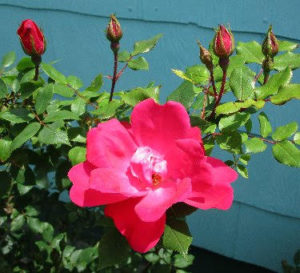
More knock-out roses
Joe Sapia, 59, is a vegetable gardener, who gardens the same backyard plot as did his Italian-American father, Joe Sr., and his Polish grandmother, Annie Poznanski Onda. Both are inspirations for his vegetable gardening. And he draws inspiration on the local Pine Barrens from his mother, Sophie Onda Sapia, who lived her whole life in the local Pines, and his grandmother.
Article and photos by Joe Mish

This female red phase screech owl with erect ear tufts and large eyes looks as ferocious as it sometimes sounds.
The calm starlit night, made blacker by the dark phase of the moon, was the perfect setting for a peaceful night’s sleep. The windows were wide open and the air scented with honeysuckle as the gentle sounds of the night played a sleepy time lullaby.
Deep sleep and dreams were well under way when a primal scream, just outside the window, vibrated the walls. Everyone sat up, hearts beating wildly, sleeping coonhounds unleashing unheard of sounds that must have been reserved in the event they ever treed the devil.
Before my heart beat slowed, I figured the sounds had to come from a screech owl perched on a tree limb six feet from the bedroom window. The unearthly screams were one selection of screech owl vocalizations that include rapid clicking of its beak and a gentle wavering call that, through association with spooky movies can easily raise the hairs on the back of your neck.
The volume of a screech owls’ motivated scream is inconsistent with its small size. The eastern screech owl is about 9 inches tall, weighs around 6 ounces with a 24 inch wingspan and easily fits through a three inch nest box hole.
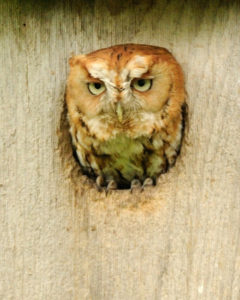
Adult red phase screech owl perches in 3″ hole of its nest box, note the feet gripping the edge of the opening.
Eastern screech owls come in two colors, a red phase and a gray phase. Its physical appearance, while perched, gives the impression it is missing the lower half of its body. During the day with its eyes shut it blends in so perfectly with its background it is difficult to tell what part is what. The owl seems to suddenly appear from the background when it opens its large yellow eyes.
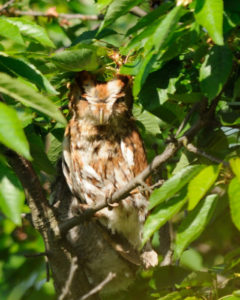
Eyes closed, these owls seems to disappear with no reference to top or bottom or recognizable form.
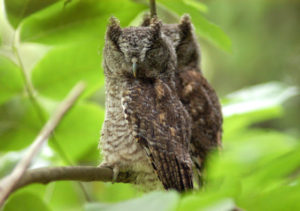
Screech owls seem to comfortably tolerate humans and can be seen, and will nest, in proximity to homes and buildings if a nest box is provided.
Late June early July, a screech owl would show up whenever I went into the backyard around dusk. It would follow me around and click its beak from a nearby branch. I have no idea what motivated that behavior but that owl provide plenty of photo opportunities.
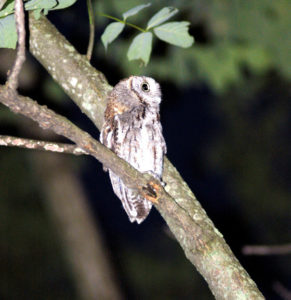
Then there were the memorable Christmas day visits. One Christmas morning I went to the open woodshed to replenish the woodstove with an armful of oak. There, staring me in the face from four feet away was a gray phase screech owl. It stayed put while I gathered the wood but was gone when I returned with my camera.
A few years later on Christmas night, a red phase screech owl perched a few feet off the ground in a weeping cherry tree. The little owl was spotted by the car’s headlights. It remained undisturbed while I did capture its image.
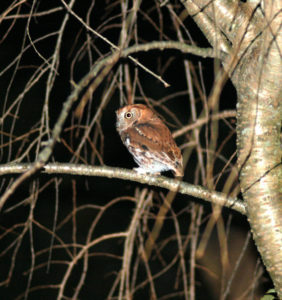
A late Christmas present in full feather, delivered at the front door.
Screech owls may just as well be found in deep woods. I have a great image of a red phase owl sitting in a healed hole in the side of a large tree trunk about eight feet off the ground. Other sightings have been in places where mature sycamore trees grow. Often, broken branches will leave a cavity that overtime becomes deeper, forming a perfect nest or day time resting place for this diminutive owl.
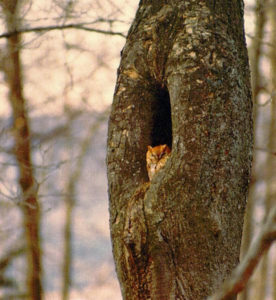
Though screech owls are quite common, you may never see one. Think of them as a night time radio host whose show you listen to all the time but never put a face to the voice. Hear a sampling of screech owl calls at: https://www.allaboutbirds.org/guide/Eastern_Screech-Owl/sounds
Author Joe Mish has been running wild in New Jersey since childhood when he found ways to escape his mother’s watchful eyes. He continues to trek the swamps, rivers and thickets seeking to share, with the residents and visitors, all of the state’s natural beauty hidden within full view. To read more of his writing and view more of his gorgeous photographs visit Winter Bear Rising, his wordpress blog. Joe’s series “Nature on the Raritan, Hidden in Plain View” runs monthly as part of the LRWP “Voices of the Watershed” series. Writing and photos used with permission from the author.
By: Heather Fenyk
Part of the fun of reading comic books when I was a kid was coming across ads for the absurd: Monster Size Monsters! X-Ray Vision Glasses! Kung-fu Sandals! (AUTHENTIC! Worn for Centuries by Oriental Fighting Masters!) But my absolute favorite adverts included invitations to “Own A Bowl Full of Happiness.” For just 49¢ plus $2.99 shipping, you could raise your own “trainable” insta-pet, the Sea Monkey.

Sea-Monkey ad from 1970’s comic book
Sea Monkeys fall into a general group of organisms including brine shrimp and “fairy shrimp” that, with the proper mix of nutrients and chemicals, can be stored in dry form and then “revived” with a dose of plain tap water.
Recent rains have nourished our New Jersey swamps and freshwater marshes, transforming seeming terra firma into vernal or ephemeral ponds. These ponds – or more specifically their “fairy shrimp” inhabitants – get me out in the field looking for Sea Monkeys.
The descriptive terms for these freshwater wetland types — “vernal” and “ephemeral” — refers to their habit of appearing in spring and being short-lived or temporary. Many vernal ponds in New Jersey and elsewhere were not protected during the post-World War II building boom. But with the passage of the New Jersey Freshwater Wetlands Protection Action in 1987, all freshwater wetlands – including these temporary wetlands – were finally granted protection. Fairy shrimp benefit directly from these protection measures.
A common species of fairy shrimp in our New Jersey vernal ponds is Eubranchipus vernalis. It grows between 0.5 and 1.5 inches in length, and other than its forked tail and large, stalked, compound eyes, its most obvious features are the 11 pairs of feathery appendages it uses for swimming, breathing and feeding. It collects algae, bacteria, protozoa, rotifers, and detritus on the feather-like structures and transfers that material to its mouth by other appendages. In addition, it will scavenge dead tadpoles, mollusks and amphibian eggs.
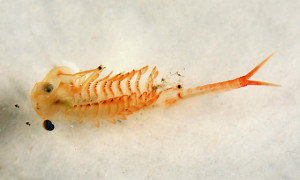
Eubranchipus vernalis. Image from www.bugguide.net
The shrimp’s reproductive strategy is fascinating. After mating, the male dies. The females are easily distinguished from males by the egg-filled brood sac on their abdomen, and the sac contains one of two types of fertilized eggs depending on the density of males in the pond. A low density of males results in thin-shelled “summer eggs,” which have a very short incubation period and hatch inside the brood sac. A high density of males results in thick-shelled “winter eggs” that eventually fall to the bottom of the pond and remain there even when the pond dries out. They will hatch the following spring, when the pond refills, and they have an amazing capacity to withstand extreme elements, including temperatures that are probably never encountered in nature: from a high of just below boiling (210 degrees) to a low extreme of -310 degrees.
The powdered thick-walled eggs of fairy shrimp are the type that my sister Julie purchased in 1978 from the back of an Archie Comic Book. It is this egg stage that enables the fairy shrimp to be distributed to other potential vernal ponds. Fairy shrimp eggs are tiny, dry granules that can be blown by the wind or picked up on the feet of animals and carried to other vernal ponds. These thick-walled, dry eggs remain viable even after 15 years, and the eggs are supposed to hatch 30 hours after being submerged in water.
Sadly, Julie’s order of Sea Monkeys never hatched. While she was perhaps permanently scarred by being duped into purchasing a package of powdered brine shrimp, I remain suckered in by the advertising and happily spend spring weekends exploring New Jersey’s vernal pools looking for my own Sea Monkeys to train.
Happy National Sea Monkey Day!
by Joe Sapia
As the 1800s turned into the 1900s, wild turkeys apparently were extinct in New Jersey.
“It’s a native species,” said Tony McBride, the state’s turkey biologist at the Division of Fish and Wildlife. “It requires large areas of upland forest interspersed with openings.”
Turkeys roost in trees, but it is important for the young to feed on insects, available in open areas, to get necessary protein.
But, at the turn of the 19th Century into the 20th Century in New Jersey, land was being cleared for farmland, resulting in the loss of forest habitat. Additionally, there were no limits on hunting turkey. Translated, turkeys disappeared in New Jersey.
“They were gone, as far as we know,” McBride said.
Today, though, the Pine Barrens Around Helmetta – as well as the rest of New Jersey, with an estimated population of 20,000 to 30,000 — are thriving with turkey. And they are easily seen – I see them often as I drive my Jeep down paved roads, for example.
Or I may get a glimpse of them in the woods, even though they are stealth and, when threatened by my approach, make sleek getaways – sometime simply scrambling into heavy understory and fitting in, camouflaged.
“They’re very wary,” McBride said. “They have good vision, hearing, and they taste good, so everything’s after them. They’re constantly on the lookout for predators.”
Turkeys can fly 55 miles per hour, once they get going.
“Turkeys are good fliers,” McBride said.
In January, I was attending an afternoon wake at a funeral home that backs up to the woods. On the funeral home grounds is open space. The funeral director mentioned how turkeys frequent the property. None were in sight when he said it, but, within minutes, there they were.
Even if one does not see them, their three-prong tracks are obvious on the ground or in snow.
“When we release birds in an area, they disperse,” said McBride, adding “every once in awhile,” turkeys, with a range of up to 2 square miles, will settle miles from the release point.
Bob Eriksen, the state turkey biologist from 1977 to 2001, said he once had a release in the Walpack area of Sussex County ending up in Sullivan County, New York, or 28 miles away.
The Pine Barrens around Helmetta have nice turkey habitat of woods and open space. Here, there is forest with farmland abutting it and utility right-of-ways cutting through it. Basically, that explains the re-population of turkeys here, apparently beginning in the late 1990s.
Looking back to the 1950s and 1960s, East Coast game farms would release turkeys. These farm-raised birds, however, “would persist (perhaps for a few years) and fizzle out,” not having the instinct for general survival and feeding, McBride said.
In the early 1970s, scientists learned restoration would be successful with releasing a “true wild stock” of adult birds, McBride said.
“There’s something to be said about these birds growing up in the wilds and passing the skills along,” McBride said.
Around 1977, 22 adult turkeys – 15 hens and seven toms – from New York and Vermont were released in Sussex County. Thus began successful restoration in New Jersey.
By 1979, New Jersey was moving around in-state birds, Eriksen said.
“When a turkey population is first established, the growth is really fast,” McBride said. “The thinking is the predators are naïve.”
Predators of eggs in the ground nests include skunk, raccoon, and crow. Predators of adults and babies include coyote, fox, red-tailed hawk, and great-horned owl.
Within four years of that 1977 release, it had been so successful “we were hunting them,” McBride said.
The Pine Barrens around Helmetta are part of Turkey Area 12, which runs north to south from the Raritan River to Interstate 195 and west to east from Trenton to the Atlantic Ocean from Sandy Hook to Belmar.
In 1995, the state opened a turkey-hunting season in Area 12, because the birds were well-established in the Sourland Mountain area to the west and the Colts Neck area to the east.
In 1996 and 1997, looking to populate the area between Sourland Mountain and Colts Neck, the state released 18 birds on Dey Road, Cranbury – eight birds over two days in January 1996 and 10 birds on Feb. 9, 1997.
A file card from Jan. 3, 1996, shows an adult female, caught in Hampton, Sussex County, and weighing 10-1/2 pounds, was released on the Simonson Farm on Dey Road in Cranbury.
Apparently these were the only two releases near the Pine Barrens around Helmetta, which are about 5 miles away. But that was all that was needed. Soon, turkeys were being recorded in those Pines.
My field notes indicate I first noticed turkey in the Pine Barrens around Helmetta in the fall of 1998.
November 28, 1999: “Turkey in tree in area behind Helen Maslanka’s house,” which is at Jamesburg Park.
January 20, 2001: “Tracks in snow by Jamesburg Dump/Manalapan Brook floodplain area.”
May 22, 2006: “Turkey, saw 2 on Washington Avenue” at Jamesburg Park.
May 25, 2008: “Saw turkey tracks in wet area” along Lincoln Boulevard.
March 24, 2010: “Saw a few wild turkeys on the other side of (Cedar) Brook, or behind the houses,” in Spotswood.
Early May, 2010: “Turkey trots up (Swing) Hill.”
April 14, 2011: “About 6:10 p.m. at the corner of Helmetta Boulevard and Old Stage Road, a turkey flew across Helmetta Boulevard from north to south.”
January 25, 2012: “A flock of turkeys in (Cranberry) Bog. Only heard them because they moved, rustled vegetation. Guess I spooked them.”
I have seen either turkey or its tracks in various places in the Pine Barrens around Helmetta: Snuffy Hollow, the Power Lines at the Cranbury Road farmland, behind Holy Cross Cemetery, in my neighborhood between Helmetta and Jamesburg, across Manalapan Brook from my neighborhood. Basically, they are all around.
Area 12 hunting records suggest the success:
In 1995, during that first season in Area 12, the area had 43 kills of the state’s 1,581. In and around the Pine Barrens around Helmetta, the kills were 3 in South Brunswick, 1 in Monroe, and 1 in East Brunswick, with no kills recorded in Helmetta, Spotswood, Jamesburg, and Old Bridge.
In 2012, Area 12 had 113 of the state’s 2,956 kills. In and around the Pine Barrens around Helmetta, the kills were 16 in Monroe, 7 in Old Bridge, 2 in Helmetta, and 1 in East Brunswick.
In Area 12, turkey hunting is allowed with shotgun or bow and arrow from late April to early May. (The state also has a fall turkey season, beginning in late October and running for one week, but that season is not open in Area 12.)
Turkeys mate from March into April. Nests are hidden on the ground, either in a field at the edge of a forest or amid shrubs or fallen tree in a forest.
“When they make their nest, you generally can’t see them,” McBride said.
A hen will lay about a dozen eggs during the last two weeks of April. About May 1, she will begin sitting on the eggs. They take 28 days to hatch – or at about Memorial Day.
A hen will re-nest to achieve successful hatchlings, laying eggs as late as mid-July.
Of the dozen or so eggs, four poults will make it to 16-weeks-old “in a good year,” McBride said. By the end of September or early October, the young are no longer dependent on the adults.
At that time, they will flock, the young staying with the hens, the adult males, “toms” or “gobblers,” forming their own groups.
Turkeys achieve adulthood at 2-years-old. Their life expectancy in the wild is 3 years.
The best turkey habitat in New Jersey is Cape May, Cumberland, Salem and south Gloucester counties, possibly along with parts of Atlantic County, McBride said. That is because these areas have prime habitat of rich forest and open space.
“Adults eat plenty of acorns, berries, other vegetative matter, and they can also rely on feed associated with dairy operations and backyard birdfeeders, especially in cold weather,” McBride said.
About a dozen years ago, the state basically stopped releasing turkeys.
“By then, we pretty much had turkeys in all of the available range in the state,” said McBride, who became the turkey biologist about that time.
Turkey restoration “skyrocketed” in the 1990s, because dry springs were perfect for nesting and the raccoon population was diminished by disease, Eriksen said.
“The New Jersey Division of Fish and Wildlife did a real good job,” said Eriksen, who, for the last 12 years has been the biologist in New Jersey, Pennsylvania, Delaware, and Maryland for the National Wild Turkey Federation. “It was a very aggressive program. The results are impressive. It was tremendous time and energy by the agency.”
Joe Sapia, 57-years-old, lives in the Pine Barrens around Helmetta, where his family has resided for more than 100 years. He can be reached at Snufftin@aol.com or at P.O. Box 275, Helmetta, 08828. This article was first circulated as an e-mail to friends in 2013.
















